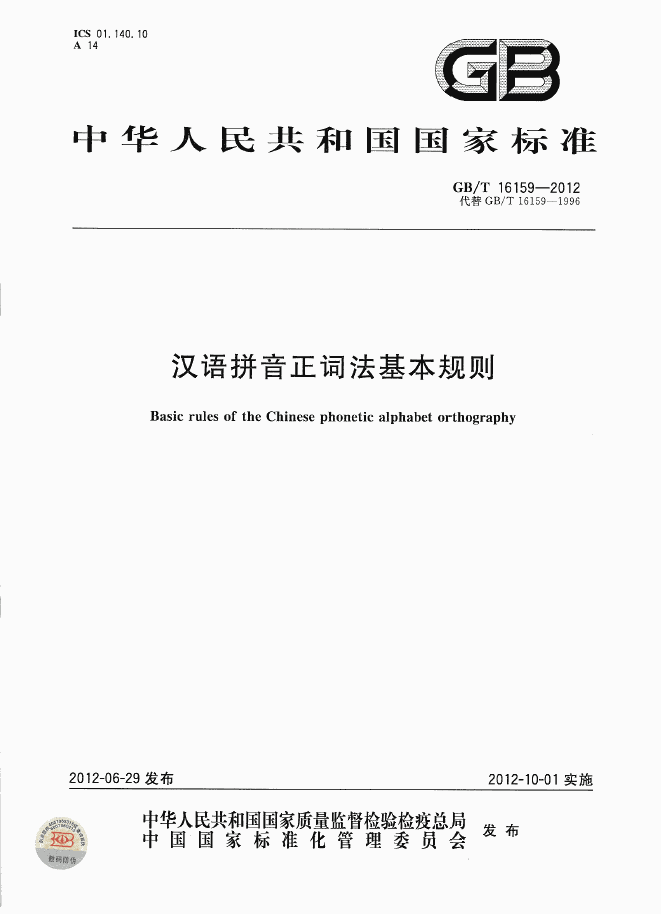In 2012 China revised its official guidelines for writing Pinyin.
These are the Hanyu Pinyin Zhengcifa Jiben Guize (official translation: “Basic Rules of the Chinese Phonetic Alphabet Orthography”), promulgated as GB/T 16159-2012.
Among the changes are that some alternate forms are now allowed, for example “wo de” (my) may also be written as “wode”. I’m not thrilled about that; but I know some people will welcome this.
I’ve added a few notes, such as for errors in the original document.
So far I have made only a version in so-called simplified Chinese characters. But eventually I’ll add one in traditional Chinese characters and an English translation.


Pingback: PRC’s official rules for Pinyin: 2012 revision — in traditional Chinese characters | Pinyin News
Notes by the webmaster of Pinyin.info
[a] Corrected from “yier-jiu (??·?)” in the original document.
> Just wonder why the correct form is not “yi’er-jiu (??·?)”
[b] Corrected from “qiankemimeimiao (??·?/?)” in the original document.
> Why correct it? It seems that in physics textbooks published in Mainland China, the unit, if written in Hanzi, is always ??·?/?. ????? is just how the unit is read.
Sorry about the scrambled Hanzi and diacritics. That’s not something I can fix yet.
a. That’s a tricky one, something I debated a bit myself. But since in Mandarin the numbers are all said as separate units (e.g., er-er-ba for Feb. 28) I opted for this. At any rate, “yier” is simply a non-starter.
b. Thanks for the info on the standard form in China. The thing about qiankemimeimiao is that if it’s written in the pattern of “XX·X/X” then the Pinyin should also have a slash (/). Then we’d have, most likely, “qianke mi/miao”. I could have corrected it to that instead; but it seems a bit less transparent. YMMV.
I have a comment about your HTML version.
Under 6.3.1, The lines right after “诗歌每行开头的字母大写。例如:” (“The first letter of each line of a poem is capitalized. For example:”) is a poem.
«Yǒude Rén» (《有的人》) – title of poem
Zāng Kèjiā (臧克家) – author of poem
Yǒude rén huózhe, (有的人活着,) – poem line 1
Tā yǐjīng sǐ le; (他已经死了;) – poem line 2
Yǒude rén sǐ le, (有的人死了,) – poem line 3
Tā hái huózhe. (他还活着。) – poem line 4
So the original document is not wrong. The line “诗歌每行开头的字母大写。例如:” and the two lines that follow HAVE TO come directly after the line “Wǒ ài wǒ de jiāxiāng. (我爱我的家乡。)” This is intended.
And under 5.3, “gūihuà” should be “guīhuà”
For 一二·九, I think “yī’èr-jiǔ” (apostrophe instead of hyphen) is correct. In fact, 现代汉语词典 (7th edition, 2016) has “【一二·九运动】 Yī’èr-Jiǔ Yùndòng” in it:
https://i.imgur.com/mNaf0yN.png
Come to think of it, “yī-èr-jiǔ” (with a hyphen between “yī” and “èr”) cannot be right.
If “yī-èr-jiǔ” is correct, both 一二·九 (December 9) and 一·二九 (January 29) become “yī-èr-jiǔ” in pinyin!
Also, there was 一·二八事变 (January 28 Incident).
https://zh.wikipedia.org/wiki/%E4%B8%80%C2%B7%E4%BA%8C%E5%85%AB%E4%BA%8B%E8%AE%8A
If 一·二八 (January 28) is transcribed as “yī-èr-bā” in pinyin, it can be easily misinterpreted as 一二·八 (December 8).
However, if we put a hyphen only between the month and the day, a clear distinction is made:
1)
一二·九 (Dec 9) yī’èr-jiǔ
一·二九 (Jan 29) yī-èrjiǔ
2)
一·二八 (Jan 28) yī-èrbā
一二·八 (Dec 8) yī’èr-bā
Therefore, 一二·九 has to be “yī’èr-jiǔ” (with an apostrophe between “yī” and “èr”), not “yī-èr-jiǔ” (with a hyphen between “yī” and “èr”).
(Also, as I wrote above, 现代汉语词典 (7th edition, 2016) transcribes 一二·九运动 as “Yī’èr-Jiǔ Yùndòng” as well.)
BTW, I wonder how 前言 became 刖吕 in your HTML version. Did you use OCR?